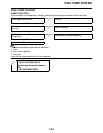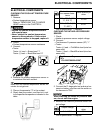
8-3
CHASSIS
2. Use of stiff spring
• Change the rebound damping.
Turn in one or two clicks.
• Change the compression damping.
Turn out one or two clicks.
Generally a stiff spring gives a stiff riding feel-
ing. Rebound damping tends to become weak-
er, resulting in lack of a sense of contact with
the road surface or in a vibrating handlebar.
FRONT FORK SETTING PARTS
• Front fork spring "1"
The I.D. mark (slits) "a" is proved on the end of
the spring.
REAR SUSPENSION SETTING
The rear suspension setting should be made
depending on the rider's feeling of an actual run
and the circuit conditions.
The rear suspension setting includes the fol-
lowing two factors:
1. Setting of spring preload
• Change the set length of the spring.
• Change the spring.
2. Setting of damping force
• Change the rebound damping.
• Change the compression damping.
CHOOSING SET LENGTH
1. Place a stand or block under the engine to
put the rear wheel above the floor, and mea-
sure the length "a" between the rear wheel
axle center and the rear fender holding bolt.
2. Remove the stand or block from the engine
and with a rider astride the seat, measure
the sunken length "b" between the rear
wheel axle center and the rear fender hold-
ing bolt.
3. Loosen the locknut "1" and make adjust-
ment by turning the spring adjuster "2" to
achieve the standard figure from the sub-
traction of the length "b" from the length "a".
TYPE
SPRING
RATE
SPRING PART
NUMBER
I.D.
MARK
(slits)
SOFT 0.459 33D-23141-20 | - ||
STD 0.469
33D-23141-30 | - |||
33D-23141-D0 —
STIFF 0.479 33D-23141-40 | - ||||
Standard figure:
90–100 mm (3.5–3.9 in)


















